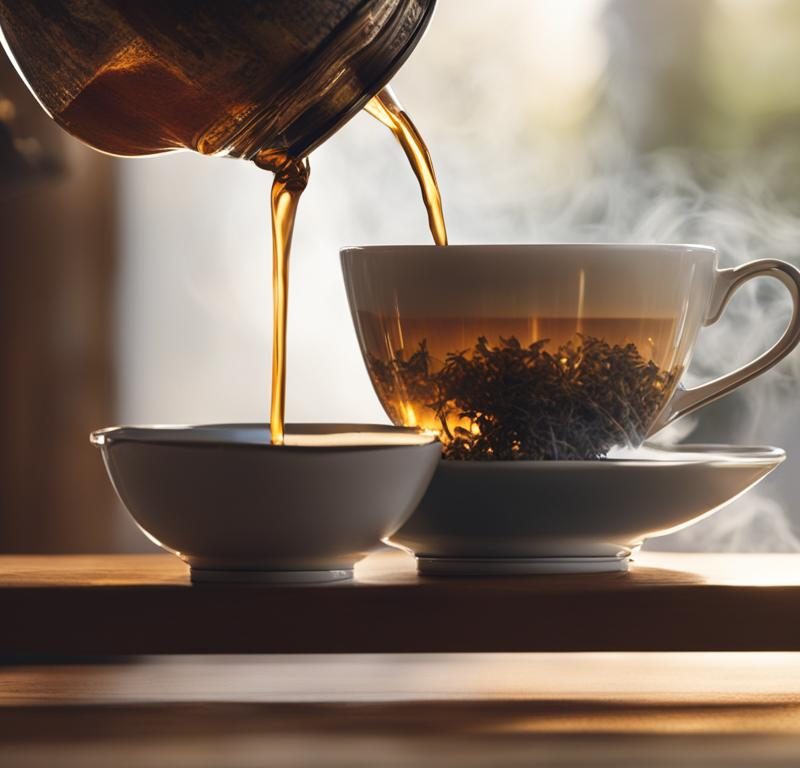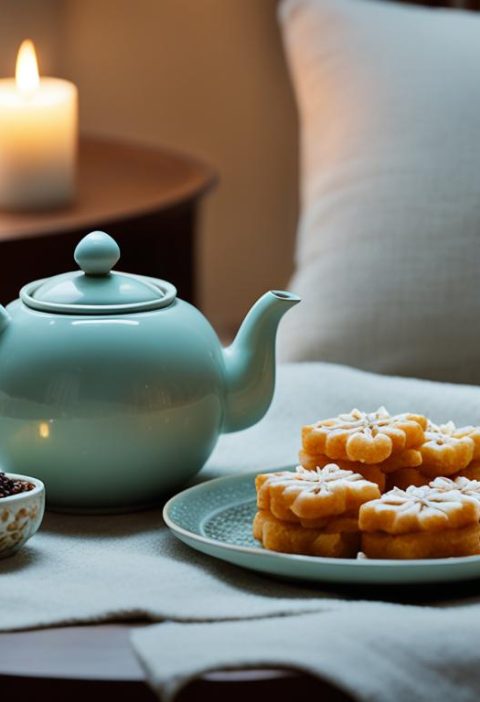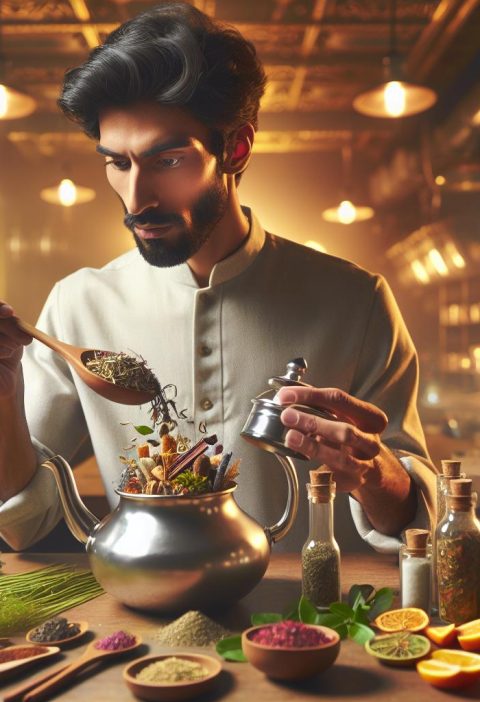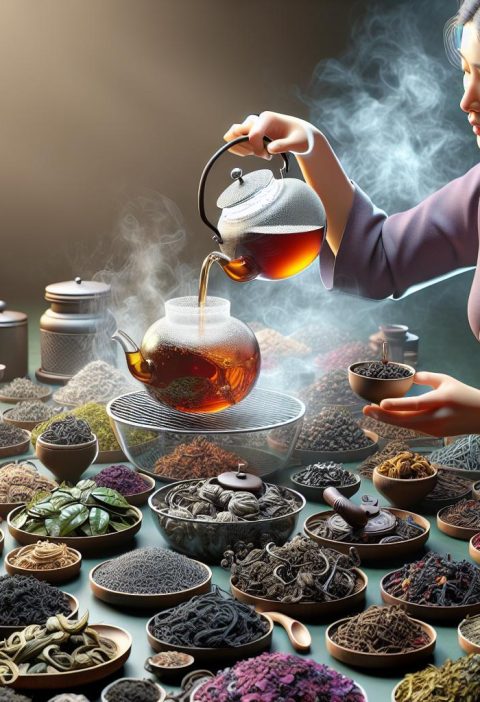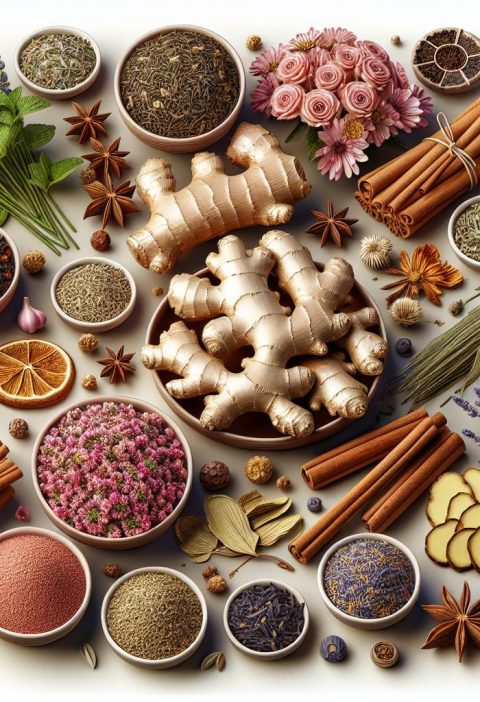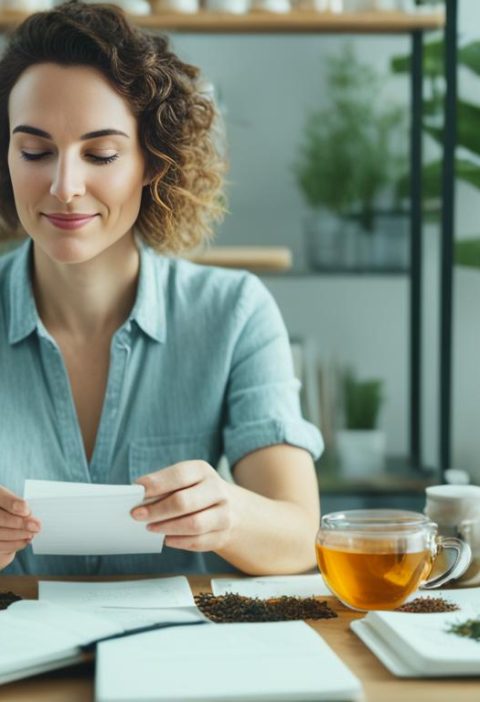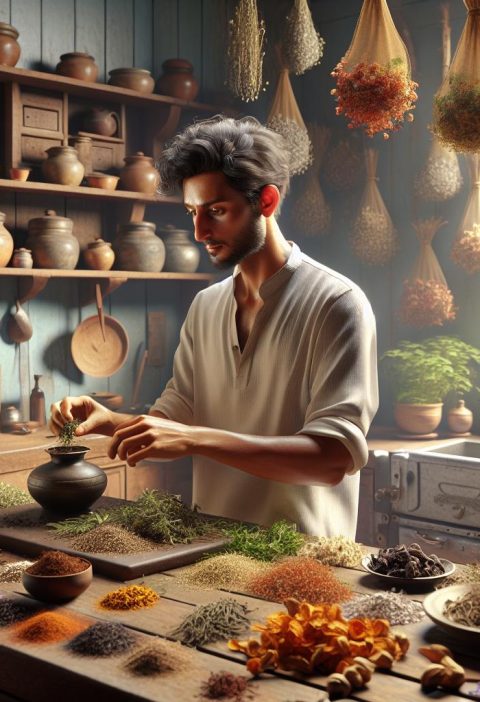Enhancing the flavors in tea steeping methods requires a deep understanding of tea infusion techniques and the factors that influence flavor extraction and development. By following the best practices for brewing tea, you can enhance the taste profiles of different teas and maximize the flavor notes they offer. In this article, we will explore various methods and techniques for achieving a more vibrant and aromatic tea experience.
Basics of Tea Steeping
To enhance the flavors in tea, it is essential to understand the basics of tea steeping. This includes following specific guidelines for tea brewing, such as controlling water temperature and steeping time. Adjustments in tea and water amounts can also be made to achieve a more concentrated flavor. By mastering these fundamental techniques, you can lay the foundation for enhancing the flavors of different teas.
Key Takeaways:
- Follow specific guidelines for tea brewing, including controlling water temperature and steeping time.
- Adjust tea and water amounts to achieve a more concentrated flavor.
Basics of Tea Steeping
To enhance the flavors in tea, it is essential to understand the basics of tea steeping. By following specific guidelines for tea brewing, such as controlling water temperature and steeping time, and making adjustments in tea and water amounts, you can achieve a more flavorful and satisfying cup of tea.
Tea steeping basics involve the careful consideration of various factors that influence the taste and aroma of your tea. Let’s explore these essential elements:
Water Temperature and Steeping Time
The water temperature and steeping time are crucial factors in extracting the desired flavors from tea leaves. Different types of tea require specific water temperatures and steeping durations for optimal results. Here are some general guidelines:
| Tea Type | Water Temperature | Steeping Time |
|---|---|---|
| Green Tea | 175°F (79°C) – 185°F (85°C) | 1-2 minutes |
| Black Tea | 195°F (90°C) – 205°F (96°C) | 3-5 minutes |
| Oolong Tea | 190°F (88°C) – 200°F (93°C) | 2-4 minutes |
| Herbal Tea | 205°F (96°C) | 5-7 minutes |
Adjusting Tea and Water Amounts
The intensity of flavor in your tea can be influenced by the amount of tea leaves and water used. Adjusting these factors allows you to tailor the strength of your brew according to personal preference. Generally, a ratio of 1 teaspoon of tea leaves per 8 ounces of water is a good starting point. You can increase or decrease the amount of tea or water to suit your taste preferences.
By mastering the basics of tea steeping, you lay the foundation for creating a flavorful and enjoyable tea-drinking experience. Understanding how water temperature, steeping time, and tea and water amounts affect the final taste allows you to experiment with different combinations and discover your perfect cup of tea.
Next, we will explore the importance of water temperature in tea flavor extraction and how to adjust it for different teas. Stay tuned!
Importance of Water Temperature
When it comes to steeping tea, the temperature of the water you use is a critical factor in determining the flavor profile of your brew. The water temperature affects the extraction of various compounds from the tea leaves, ultimately influencing the taste experience. Let’s explore the significance of water temperature in creating a perfectly balanced cup of tea.
Hotter vs. Cooler Water:
Using hotter water generally extracts more flavor from the tea leaves, allowing for a stronger and more robust brew. However, it’s essential to note that hotter water can also bring out bitterness in tea due to the extraction of caffeine and catechin. On the other hand, cooler water temperature can help extract the sweet and umami flavors of the tea without intensifying the bitterness. The choice between hotter and cooler water depends on your preference for a more robust or smoother cup of tea.
Pro tip: For delicate teas such as green and white teas, using cooler water around 170°F (77°C) can help preserve their subtler flavors and prevent bitterness.
Extracting Bitter and Sweet/Umami Flavors:
Water temperature significantly impacts the extraction of different flavor components in tea. Hotter water tends to extract more bitter compounds, such as tannins, which can result in a more astringent and bitter taste. On the other hand, cooler water temperature helps highlight the sweet and umami flavors of tea, providing a more balanced and nuanced taste experience. By controlling the water temperature, you can finely tune the extraction process to achieve the desired flavor profile in your cup of tea.
Pro tip: Experiment with different water temperatures to find the optimal balance of flavors in your favorite teas. Pay attention to how variations in temperature affect the taste, and adjust accordingly to suit your preferences.
| Water Temperature | Taste Profile |
|---|---|
| Hot Water (around 200°F/93°C) | Bolder, stronger flavors with potential bitterness |
| Cooler Water (around 170°F/77°C) | Milder, smoother flavors with enhanced sweetness |
Table: Influence of Water Temperature on Tea Flavor
Steeping Time and Tea Type
Different types of tea require varying steeping times to achieve the desired flavor profiles. By understanding the ideal steeping times for different teas, we can have greater control over flavor intensity.
Quick Steeps vs. Longer Steeps
When it comes to steeping tea, the duration of steeping plays a key role in flavor extraction. Quick steeps, involving shorter steeping times, can result in a lighter and more delicate flavor. On the other hand, longer steeps can produce a stronger and bolder taste. Adjusting the steeping time allows us to tailor the flavor intensity according to personal preference.
Steeping Time for Different Tea Types
Each type of tea has its own recommended steeping time to bring out its unique flavors. Here is a general guideline:
| Tea Type | Steeping Time |
|---|---|
| Green Tea | 1-3 minutes |
| Black Tea | 3-5 minutes |
| Oolong Tea | 2-4 minutes |
| White Tea | 4-6 minutes |
| Herbal Tea | 5-7 minutes |
These are just general guidelines, and individual preferences may vary. It’s best to experiment and adjust the steeping time to achieve the desired flavor profile for each tea.
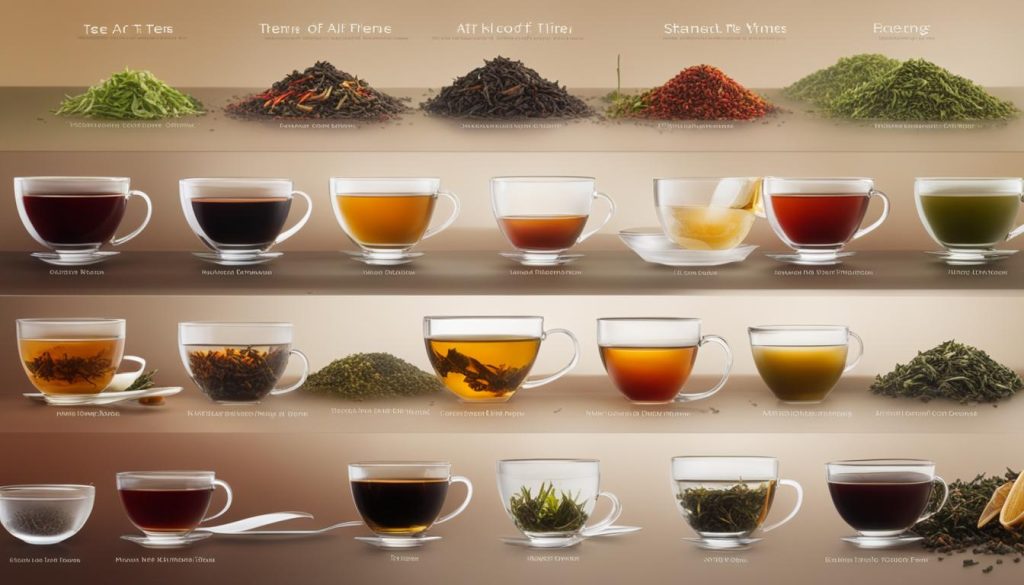
By understanding the optimal steeping times for different teas, we can unlock their true flavors and enhance our tea-drinking experience. Whether you prefer a quick steep for a subtle taste or a longer steep for a stronger brew, adjusting the steeping time allows you to tailor the flavor intensity to your liking. Experiment with different steeping times and discover the perfect balance of flavors in your tea.
Multiple Steeping Technique
The multiple steeping technique is a popular method used in Japanese green tea brewing. It offers a unique way to blend and average out flavor notes, creating a harmonious and balanced tea experience. Instead of making a large pot of tea, we use a small pot to serve one cup or two cups for two people.
Here’s how it works:
- Start by steeping the tea leaves for the first cup as you normally would.
- After finishing the first cup, rather than discarding the leaves, steep them again for a second cup.
- For a third cup, repeat the process and steep the leaves once more.
This multiple steeping technique allows us to explore different flavor profiles with each cup. The first cup may highlight the more delicate and subtle flavors, while the subsequent cups may showcase deeper and richer notes. By averaging out the flavor notes over multiple steepings, we can truly appreciate the complexity of the tea and enjoy a more layered taste experience.
Not only does this technique enhance the flavor blending, but it also provides the opportunity to make multiple servings from a single portion of tea leaves. It’s a great way to savor the tea and make the most out of your tea leaves.
To make the most of the multiple steeping technique, it’s important to use high-quality tea leaves and follow the recommended steeping time and water temperature for the specific type of tea you’re brewing. This ensures that you extract the optimal flavors from the leaves in each steeping.
Next, let’s explore another technique called the slurping technique, which can further enhance the flavor and aroma of your tea.
Slurping Technique
Slurping tea is a unique technique that can enhance the overall flavor of the tea. It involves sipping a small amount of tea and drawing in air through pursed lips to cool the tea and release more flavor compounds. Slurping allows the tea to spread across the entire surface of the tongue, picking up flavor molecules and enhancing our ability to detect different flavors and aromas. This mindful tasting technique adds a layer of complexity to the tea and promotes a more enjoyable tea-drinking experience.
| Benefits of Slurping Tea | How to Perform the Slurping Technique |
|---|---|
|
|
Brewing Methods for Different Teas
When it comes to enhancing the flavors of different teas, there are various brewing methods that can be employed. Each method brings out unique aspects of the tea’s flavor profile, allowing you to experience a diverse range of tastes and aromas. In this section, we will explore some popular brewing methods that can elevate your tea-drinking experience.
Gong Fu Cha
The Gong Fu Cha brewing method is a traditional Chinese tea ceremony that involves concentrated brewing in small vessels. This technique allows for multiple short infusions, revealing the evolving nuances of flavors in the tea. Gong Fu Cha is especially well-suited for oolong and pu-erh teas, which are known for their complex flavors and aromas.
Pin Cha
Pin Cha is a simpler brewing technique that focuses on highlighting the inherent flavors of the tea. This method involves using a larger teapot and steeping the tea for a longer period. Pin Cha is often favored for black teas, which have robust flavors that can withstand longer steeping times.
Brewing in a (Glass) Teapot
Brewing tea in a teapot, particularly one made of glass, offers a visually appealing and elegant way to enjoy your tea. The glass teapot allows you to observe the tea leaves unfurling and the color of the liquor changing, adding to the overall sensory experience. This method is suitable for a wide range of teas, from delicate white teas to bold black teas.
Brewing in a Glass
If you prefer a minimalist and uncomplicated brewing method, brewing tea directly in a glass is a convenient and practical option. This method involves adding tea leaves directly to a glass and pouring hot water over them. The transparency of the glass allows you to appreciate the visual aspects of the tea, such as the color and clarity. Brewing in a glass is well-suited for lighter teas that require shorter steeping times.
Zhu Cha Boiling Tea
Zhu Cha Boiling Tea is an ancient method of tea preparation that involves extended boiling to extract the maximum flavor from certain types of teas. This method is commonly used for strong and robust teas like black tea or pu-erh tea. Boiling the tea for an extended period results in a rich and intense brew, perfect for those who enjoy bold flavors.
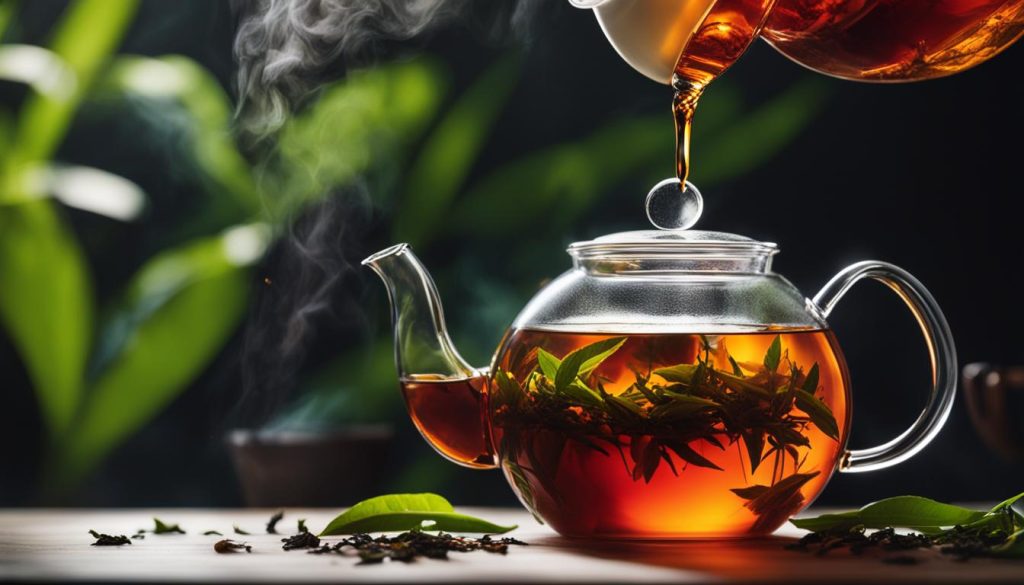
Now that we’ve explored different brewing methods for enhancing the flavors of various teas, you can choose the method that suits your preferences and the type of tea you’re brewing. Experimenting with different techniques will allow you to discover new flavors and aromas in your favorite teas.
The Role of Temperature in Tea Enjoyment
The temperature at which we drink our tea plays a pivotal role in our overall enjoyment and perception of flavor. Whether it’s the soothing power of hot drinks or the cooling effect of cold drinks, temperature significantly impacts our tea-drinking experience.
Hot drinks, like a steaming cup of tea, have a comforting and soothing effect on our senses. The warmth envelops us, creating a sense of coziness and relaxation. It’s the perfect companion to unwind after a long day or during chilly weather.
Cold drinks, on the other hand, provide refreshing relief, especially on a hot summer day or after a strenuous workout. Sipping ice-cold tea revitalizes and rejuvenates us, quenching our thirst and cooling our bodies.
Aside from the sensory experience, the ritual of hot beverages adds an extra layer of enjoyment to tea drinking. It creates a cozy atmosphere, whether it’s an intimate moment alone or a social gathering with loved ones. The act of brewing, pouring, and savoring a hot cup of tea can be a cherished ritual that brings people together.
Furthermore, proper hydration is essential for our overall well-being, and warm beverages can contribute to our daily fluid intake. Drinking warm tea aids in digestion, soothes the stomach, and promotes a sense of well-being. It can also provide additional health benefits, such as reducing stress and supporting our immune system.
To fully savor the joys of tea, it’s important to understand the role of temperature and make informed choices about our tea-drinking preferences. Whether we seek the soothing power of hot drinks or the cooling effect of cold drinks, temperature is key in creating the perfect tea-drinking experience.
| Temperature | Hot Drinks | Cold Drinks |
|---|---|---|
| Hot | Provides comfort and relaxation | – |
| Cold | – | Offers refreshment and cooling effect |
| Ritual | Enhances the tea-drinking experience | – |
| Health Benefits | Aids in digestion and provides soothing effects | Quenches thirst and promotes revitalization |
The Art of Tea Drinking
Tea drinking is a time-honored tradition celebrated in many cultures worldwide. It encompasses much more than simply sipping a beverage; it is a sensory experience that engages our senses and soothes our souls.
The delicate aromas of different teas entice us, awakening our sense of smell and transporting us to tranquil environments. The warmth of a freshly brewed cup of tea envelops us, providing comfort and a moment of relaxation in our hectic lives. As we prepare our tea, whether through the traditional methods of the East or the elegant processes of the West, we engage in a meditative practice that allows us to focus, center ourselves, and appreciate the present moment.
Enhancing the tea-drinking ritual goes far beyond the act of brewing tea; it involves the conscious selection of teaware, the careful consideration of brewing techniques, and the creation of a welcoming environment in which to enjoy our tea.
By choosing teaware that suits our preferences and enhances the sensory experience, we can elevate the act of tea drinking to a whole new level. Whether it’s the elegance of a porcelain teacup, the simplicity of a glass teapot, or the earthiness of a traditional clay teapot, the vessel we use to hold our tea can influence our perception of its flavor and aroma.
Furthermore, by adopting different brewing techniques, we can unlock the full potential of tea’s flavors and aromas. Whether it’s the precision and concentration of Gong Fu Cha or the simplicity and clarity of Pin Cha, each method offers a unique way to engage with the tea and explore its nuances.
Finally, the setting in which we enjoy our tea can contribute to the art of tea drinking. Whether it’s the calmness of a traditional tea room, the cozy ambiance of an intimate gathering, or the simplicity of a solitary moment, the environment in which we savor our tea can shape our overall tea-drinking experience.
In conclusion, tea drinking is not just a beverage; it is a time-honored tradition that celebrates the aromas, warmth, and meditation of tea. By enhancing the tea-drinking ritual through the careful selection of teaware, the adoption of different brewing techniques, and the creation of a welcoming environment, we can fully appreciate the flavors and aromas that different teas have to offer. So, let us embark on this artful journey and discover the beauty that lies within the world of tea.
Exploring the Sensory Experience with Tea
When it comes to tea, there is so much more than just a simple beverage. It is an opportunity to engage our senses, dive into the world of flavors and aromas, and create a truly immersive experience. By enhancing the tea flavors and aromas through various brewing techniques, we can unlock a whole new level of enjoyment. But it doesn’t stop there. Analyzing the strength of flavors and their lingering effects allows us to fully understand the subtleties and complexities of different teas. And finally, mindful tasting takes us on a journey of relaxation, focus, and a deeper connection with the tea we drink.
By paying attention to enhancing tea flavors and aromas, we can transform a regular cup of tea into a delightful sensory experience. Here are some techniques to consider:
- Brewing Temperature and Time: Adjusting the temperature and time of steeping can have a significant impact on the flavor profile of the tea. Experiment with different temperatures and times to find the perfect balance for the tea you’re enjoying.
- Teaware Selection: Using the right teapot or teacup can enhance the aroma and visual appeal of the tea. Choosing a teapot or teacup that allows you to see the tea leaves and the color of the liquor can add to the overall experience.
- Savoring Mindfully: Engage all your senses when tasting tea. Observe the color, inhale the aroma, and take small sips, allowing the flavors to unfold gradually on your palate. Focus on the taste, texture, and the way the tea lingers in your mouth.
Enhancing Tea Flavors and Aromas
Enhancing tea flavors and aromas requires us to be mindful of the brewing process. Here are a few techniques to try:
- Adjusting Brewing Parameters: Experiment with the amount of tea leaves, water temperature, and steeping time to find the perfect balance that brings out the desired flavors. Keep in mind that different teas require different brewing parameters, so take notes and keep track of what works best for each type of tea.
- Aromatic Additions: Enhance the flavors and aromas of your tea by adding complementary ingredients such as fresh herbs, dried flowers, or citrus zest. These additions can elevate the overall sensory experience.
- Tea Blending: Get creative and blend different teas together to create unique flavor profiles. Experimenting with different combinations can lead to unexpected and delightful results.
By employing these techniques, you can take your tea tasting to a whole new level, experiencing the depth and complexity of flavors and aromas that tea has to offer.
Analyzing Flavor Strength and Lingering
When tasting tea, pay attention to the strength of flavors and how they linger on your palate. This analysis can help you understand the nuances of different teas and appreciate their unique qualities. Here are some tips for analyzing flavor strength and lingering:
- Taste Layering: Take note of the different flavor notes that unfold as you sip your tea. Is it a burst of sweetness followed by a subtle hint of bitterness? Does the flavor evolve and change as you continue to sip? By identifying and appreciating these layers of flavor, you can deepen your understanding of the tea.
- Aftertaste: Pay attention to the lingering flavors that remain in your mouth after you’ve finished your tea. Does the taste linger for a long time or fade quickly? Is it pleasant and enjoyable or does it leave an unpleasant aftertaste? Evaluating the aftertaste can provide valuable insights into the quality and complexity of the tea.
By analyzing flavor strength and lingering, you can develop a refined palate and better appreciate the intricate flavors of different teas.
Mindful Tasting for a More Immersive Experience
When it comes to tea, taking a moment to be fully present and engaged can enhance the overall tasting experience. Mindful tasting allows you to cultivate a deeper connection with the tea and fully appreciate its flavors and aromas. Here are some tips for a more immersive tea experience:
- Silence and Focus: Find a quiet and comfortable space where you can fully dedicate your attention to the tea. Minimize distractions and allow yourself to fully engage with the sensory experience.
- Awareness of Body and Mind: As you sip your tea, pay attention to how it feels in your mouth, the warmth or coolness it brings, and the sensations it evokes. Notice any changes in your mood or energy levels as you savor the tea.
- Gratitude and Appreciation: Cultivate a sense of gratitude for the tea and all the hands that were involved in its journey from the tea gardens to your cup. Reflect upon the cultural and historical significance of tea, and let it enrich your tea-drinking experience.
By practicing mindful tasting, you can create a deeper connection with the tea and allow yourself to fully immerse in the sensory pleasure it provides.
| Technique | Description |
|---|---|
| Enhancing Tea Flavors and Aromas | Taking steps to maximize the flavors and aromas of tea through brewing techniques, aromatic additions, and tea blending. |
| Analyzing Flavor Strength and Lingering | Deliberately evaluating the intensity of flavors and how they linger on the palate to deepen the understanding of different tea profiles. |
| Mindful Tasting for a More Immersive Experience | Engaging all the senses, being present in the moment, and cultivating a deeper connection with the tea to fully appreciate its taste and aroma. |
Enhancing the flavors, analyzing the strength, and savoring mindfully can elevate your tea-drinking experience to new heights. By embracing the sensory aspects of tea, you can truly unlock the magic in every cup.
Conclusion
Enhancing the flavors of tea is an art that can be mastered through practice and knowledge. By understanding the factors that influence flavor extraction, such as water temperature, steeping time, and brewing techniques, we can unlock the secrets to a more vibrant and aromatic tea experience. Experimenting with different methods and exploring the sensory aspects of tea drinking allows us to fully appreciate the diverse flavors and aromas that different teas have to offer.
From controlling water temperature to adjusting steeping times, every choice we make during the tea steeping process can have a significant impact on the final flavor of our tea. By following best practices and understanding the characteristics of each tea type, we can enhance the taste profile and maximize the flavor notes. Whether it’s a warm cup of tea to soothe our senses or a refreshing iced tea to cool down on a hot day, the journey of unlocking the secrets of tea steeping brings us closer to a more vibrant and aromatic tea experience.
So, the next time you brew a cup of tea, remember to pay attention to the details and explore the possibilities. By embracing the art of tea steeping and being mindful of the flavors and aromas that unfold, you can create a truly exquisite tea-drinking experience. Cheers to enhancing flavors in tea, and may every sip bring you joy and satisfaction!
